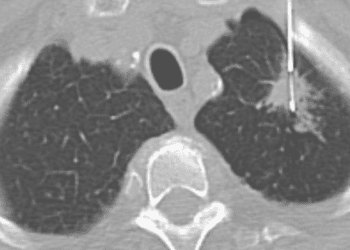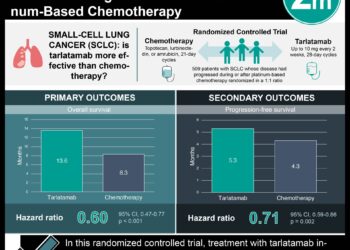Sinoatrial node radiation associated with the development of atrial fibrillation and mortality in lung cancer
1. The maximum dose delivered to the sinoatrial node had the highest predictive value for atrial fibrillation.
2. A higher sinus node radiation dose was significantly associated with poor overall survival in SCLC and NSCLC patients.
Evidence Rating Level: 2 (Good)
Study Rundown: While thoracic radiotherapy can increase the risk of various cardiac adverse events, studies on radiation-induced cardiotoxic effects have mainly focused on ischemic heart disease. This study explored the association between radiation dose exposure to cardiac substructures with cardiac toxic effects and survival in lung cancer patients who received chemoradiotherapy. Atrial fibrillation (AF) was a specific cardiac event of interest. Of the cardiac substructures evaluated, the maximum dose (Dmax) delivered to the sinoatrial node (SAN Dmax) had the highest predictive value for AF. While a higher SAN Dmax significantly predicted a higher risk of AF in patients with small-cell lung cancer (SCLC) and non-small-cell lung cancer (NSCLC) patients, it had no association with non-AF cardiac events. A higher SAN Dmax was also significantly associated with poor overall survival (OS) in both lung cancer cohorts. Other cardiac substructures that demonstrated a predictive value was the right atrium. The strength of this study was that it found a specific association between SAN Dmax and AF, given that the former had no significant predictive value on non-AF cardiac events. It was also able to find the optimal SAN Dmax cutoff values, above which the risk of AF is significantly increased. Limitations to this study include its predominantly male population and its retrospective design, where patients were not prospectively followed up for cardiac adverse effects. Overall, incidental radiation of the SAN is linked to the development of AF and reduced survival.
Click to read the study in JAMA Oncology
Relevant Reading: Past, present, and future of radiation-induced cardiotoxicity: refinements in targeting, surveillance, and risk stratification
In-Depth [retrospective cohort]: This single center retrospective study included 239 patients with SCLC and 321 patients with NSCLC who had received chemoradiotherapy. In the SCLC and NSCLC cohorts, 9 patients and 17 patients experienced new-onset AF, respectively. SAN Dmax yielded the highest C index (0.66; 95% confidence interval [CI], 0.56 to 0.74) of all other cardiac substructures for the prediction of AF in the combined cohort of SCLC and NSCLC. The optimal SAN Dmax cutoff level was 53.5 Gy (95% CI, 48.9 to 53.7 Gy) and 20.0 Gy (95% CI, 2.5 to 43.5 Gy) for SLCL and NSCLC cohorts, respectively. Patients who received radiation above their respective SAN Dmax cutoffs exhibited a higher incidence of AF (SCLC, adjusted hazard ratio [aHR], 14.91; 95% CI, 4.00 to 55.56; P < 0.001; and NSCLC, aHR, 15.67; 95% CI, 2.08 to 118.20; P = 0.008). Similarly, patients who received radiation above their respective SAN Dmax cutoffs exhibited a worse OS (SCLC, aHR, 2.68; 95% CI, 1.53 to 4.71; P < 0.001; and NSCLC, aHR, 1.97; 95% CI, 1.45 to 2.68; P < 0.001). Overall, radiation exposure to the SAN was significantly associated with development of AF and increased mortality in SCLC and NSLC patients.
Image: PD
©2022 2 Minute Medicine, Inc. All rights reserved. No works may be reproduced without expressed written consent from 2 Minute Medicine, Inc. Inquire about licensing here. No article should be construed as medical advice and is not intended as such by the authors or by 2 Minute Medicine, Inc.







![Reduced neuronal BRCA1 associated with decreased DNA repair in Alzheimer’s disease [PreClinical]](https://www.2minutemedicine.com/wp-content/uploads/2015/12/DNA_Furchen_edited-75x75.png)